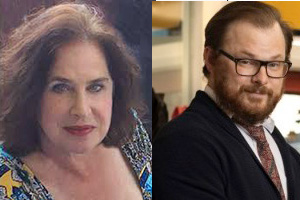Features
Not without honour…..except here

By SIMONE COHEN SCOTT Several Wednesday nights ago, June 22nd to be exact, I attended a launching here in Winnipeg, at the Whodunit Bookstore to be exact, of Celia Rabinovitch’s book, “Duchamp’s Pipe; a Chess Romance.” Actually, the book has been launched in a few places, mostly via zoom. Readers of this paper may even remember that I reviewed her book a while back.
(Ed. note: It was actually December 2020, Simone – and your review is on our website at http://jewishpostandnews.ca/8-features/640-new-book-by-noted-art-expert-celia-rabinovitch-explores-many-themes.)
Anyway, the event back in June was delightful. The evening was basically a conversation between Dr. Michael Bumsted, proprietor of the store, and Celia Rabinovitch, internationally celebrated, locally barely known, artist, writer, and cultural historian. They were well-matched, the extremely erudite Dr. Bumsted, educated in Scotland, and Celia, Director of University of Manitoba’s Fine Arts Department, 2002-2008; scholar-in-residence at universities in North America, Europe, and Israel; her paintings appearing in art centres throughout Canada and the United States albeit seldom here. His questions about the book were incisive and penetrating, her answers thoughtful, informative, interesting, and amusing. She is a wonderful raconteur and his method encouraged her to tell of the many adventures that went into the researching and writing the book. It was apparent he had read the book carefully and had had fun doing so.
Of course they talked about pipes, but also about bohemian life in various cities throughout two continents during the war-dominated decades of the early 20th century, travelling via tramp steamer, partying with the privileged, barely eking out a living. Histories at several levels are revealed through the medium of chess tournaments, against the backdrop of a not so unlikely friendship, that of George Koltanowski, a passionate chess playing phenomenon who practically breathed the game, (Good heavens, he could play several opponents at once, blindfolded, and win!), and Marcel Duchamps, the sophisticated chess aficionado, who had already made his name initiating a startling genre into the world of art with his ‘Nude Descending a Staircase’. The central character is the pipe; it provides the theme connecting the two men who, in fact, spend just scraps of time with each other over the decades-long era their stories cover. Both Bumsted and Rabinovitch are well versed in many aspects of early 20th century histories in several locales. The audience, seated on metal folding chairs in the centre of the store, half-emptied platters of goodies behind them, had their horizons broadened. There was a flurry to buy the book after this presentation.
My own friendship with Celia began through a mutual friend, actress Terri Cherniak. Celia was to spend a couple of weeks as scholar-in-residence at the Israel Museum, lecturing on Dada art, and Terri knew I had an apartment nearby. She put us in touch. We were roommates for two weeks, we hit it off, and a friendship grew. Celia is, to me, a citizen of the world. She has an aura about her that makes one feel something special is going on. She is aware, always, of the spiritual connection between people, their settings, the objects they love, and she perpetuates the idea that the love passes along with the object. This informs her paintings, and this is the story of the pipe. The thread of love connection permeated every aspect of its journey as the gift from Marcel to George and beyond, (George re-gifted it), until finally, because it was Duchamp’s pipe, it was auctioned off for tens of thousands of dollars. Perhaps the pipe is laughing now.
A second perspective of the thread of love, binding the souls of the two men, is the game of chess, which accounts for the rest of the book’s title, ‘a Chess Romance’. One feels as one reads the book that little wisps of je ne sais quoi are whirling about in the atmosphere, twirling themselves around your mind, giving it ideas. Of course, anyone familiar with Celia’s previous book, entitled “Surrealism and the Sacred: Power, Eros, and the Occult in Modern Art”.wouldn’t be surprised by this mystic quality. One senses it in her art as well. An unidentified quote sums it up thus: “Her luminous paintings evoke mood, atmosphere, and ambiguity, leading to a sense of the uncanny.”
The Whodunit Bookstore has a story too. It was founded as an activity for Michael. Bumsted’s father when he retired. As a mystery buff’s oasis, it thrived. My own introduction to “Whodunit” happened when I began to winter in Israel; I asked the elder Mr. Bumsted to find me mysteries set there. The several he found for me added greatly to my grasp of the neighbourhoodsof the country. Mr. Bumsted was an historian and customers flocked to his evenings of readings and discussions, to hear his stories and to buy his recommendations. Soon Mrs. Bumsted, also an historian, was needed to help in the business.
That is when the merchandise begins to reach beyond thrillers. As Mrs. Bumsted would include books for her grandchildren in some of her orders, one day when a few were inadvertently left out on the counter, they were noticed and ultimately sold. It made sense; since people who like books have children and grandchildren – make it convenient for them. So children’s books were stocked, and then one thing led to another. When the space next door became vacant, Whodunit expanded to twice the size.
By this time, son (and recent PhD) Dr. Michael Bumsted had returned from Scotland. A career in a book store was not, I suppose, his intention, but hey! It turned out to be a good fit. As the range of books filled the shelves, his eclectic interests were being met. As I’ve already mentioned, I was impressed with erudite remarks and penetrating questions with which he drew out Celia’s fascinating anecdotes, and the ensuing discussion. If the evening sessions discussing books that he facilitates at Whodunit are as engrossing as the one I attended, you’ll see me at more.
A week and a half prior to this event, Celia spoke at the Manitoba Museum about the exhibit she curated there, of photographs taken by Nick Yudell, a first cousin of Celia’s once removed. Left in the possession of a family member, they were really a gift to Canada prepared for us by this young photographer – fated to die in WWII as an RAF pilot. Whereas a less sensitive person might have left them in their carefully labelled boxes, seeing how much love went into the taking of these photos, as one artist to another, Celia undertook to prepare them for display, to be shared with the world. At a point when we were together in one of the rooms of the display, Celia confided to me that she had wanted to convey the fact that although Nick’s photos feature his own community, which was Jewish, the story he is telling is about the every-man in Canada during the wartime period, that is, a story of patriotic men of courage and of strength. We who were children then, remember them. She surely succeeded; staff and patrons got it. The exhibit, originally meant to end August 1st, has been held over to December 18th.
Features
Is This the End of Jewish Life in Western Countries?

By HENRY SREBRNIK “Globalize the Intifada” has been the chant echoing through streets since October 7th, 2023. It was never a metaphor, and we now see the gruesome results across the western world, from Australia to Canada: the rise of groups of large, active networks of Islamist and anti-Zionist organizations.
Jews in the West are discovering that the nations they defended, enriched, and profoundly shaped have become increasingly inhospitable. After the Holocaust, explicit Jew-hatred became unfashionable in polite society, but the impulse never disappeared. The workaround was simple: separate Zionism from Judaism in name, then recycle every old anti-Jewish trope and pin it on “the Zionists.”
We have seen the full legitimization of genocidal anti-Zionism and its enthusiastic adoption by large segments of the public. The protests themselves, as they began immediately on October 7th, were celebrations of the Hamas massacres. The encampments, the building occupations, the harassment campaigns against Jewish students, the open calls for intifada, the attacks on Jews and Jewish places have become our new norm. History shows us that antisemitism does not respond to reason, incentive or the honest appeals of the Jewish community.
Outside the United States, there is no Western political establishment with either the will or the capability to address this problem, let alone reverse its growth. I’m sorry to say this, but the future of Western Europe, Canada, Australia, and New Zealand is likely to be increasingly Jew-free.
Today, police stand and watch mobs chant for Israel’s destruction, call for the genocide of its people, harass visibly Jewish citizens, and drive antisemitic intimidation deep into urban life. They now believe their job is to enforce the law only if it does not risk upsetting violent constituencies. This makes Jews expendable, because defending them risks confrontation. This was very clear in the Bondi Beach massacre.
Jews are again donning caps instead of kippot, dressing generically with no cultural markers, and avoiding even a tote bag with Hebrew on it. A corrosive creep toward informal segregation in retail and service sectors is occurring, as Jewish customers report being refused service. A mezuzah hanging from a rideshare mirror leads to cancellations. When Jews express frustration, they are accused of exaggeration or attempting to suppress criticism of Israel. Jewish fear is not treated as a real problem.
“Jews Are Being Sent Back into Hiding,” the title of a Dec. 15 article in the New York Free Press by David Wolpe and Deborah Lipstadt, asserts that the attacks on Jews, including physical assaults, social media campaigns and, most tragically, the recent murders in Australia, are part of a purposive campaign designed to make Jews think twice about gathering with other Jews, entering a synagogue, going to kosher restaurants, putting a mezuzah on the doorpost of their apartments or dorm rooms, or wearing a Jewish star around their necks.
“We know of no one who would consider giving a niece, nephew, grandchild, or young friend a Jewish star without first asking permission of their parents,” they write. The unspoken, and sometimes spoken, question is: “Might wearing a star endanger your child’s well-being?”
Recently, a prominent American rabbi was entering a Target store in Chicago with her grandson, whom she had picked up from his Jewish day school. As they walked into the store the 10-year-old reached up and automatically took off his kippah and put it in his pocket. Seeing his grandmother’s quizzical look, he explained: “Mommy wants me to do that.”
Borrowing a phrase from another form of bigotry, they contend that Jews are going “back into the closet.” No public celebration of Hanukkah took place in 2025 without a significant police presence. Some people chose to stay home.
Lipstadt and Wolpe know whereof they speak. They are respectively a professor of history and Holocaust studies who served as the Biden administration’s ambassador tasked with combating antisemitism, the other a rabbi who travels to Jewish communities throughout the world, and who served on Harvard’s antisemitism task force in the aftermath of the October 7, 2023 pogrom.
What the world has seen over the past two years is a continual, often systematic attempt to terrorize Jews. When political leaders fail to condemn rather than merely “discourage” chants of “globalize the intifada,” we are seeding the ground for massacres like the Hannukah one in Sydney.
If each Jewish holiday will now be seen by antisemites as an opportunity for terror, then the prognosis for diaspora Jewry is bleak. There will be fewer public events, more alarms, more bag checks at doors; there will have to be more security and more police. Unless things change, Jewish life in the diaspora will become more sealed off from the larger society.
Why has this failure come about? Confronting antisemitism, stopping the mobs, challenging the activists, and disciplining antisemitic bureaucrats all carry electoral risk for politicians; Jews are demographically irrelevant, especially compared with Muslim voters, with the U.S. being the only partial exception.
There are those who suggest Jews stop donating funds to educational and other institutions that have turned against us. At this point, I doubt very much that withdrawing dollars will have an impact. For every dollar withdrawn, there will be 100 from Qatar and other sources in its place.
Throughout history, the way a society treats its Jews predicts its future with unerring accuracy. If Jews leave, it will be because a civilization that will not defend its Jews will also defend next to nothing and may itself not survive.
Henry Srebrnik is a professor of political science at the University of Prince Edward Island
Features
Canadian Travel Trends 2025 and the Forecast for 2026

Canadians planning to travel in 2026 should keep an eye on shifting trends and learn what’s coming their way in the new year.
Canadian travel has seen a fair amount of change and instability over the last few years, thanks mostly to the country’s southern neighbours. In 2025, and likely into 2026, travel trends in the Great White North have stabilized significantly, with more Canadians than ever choosing to travel within their own borders. And with 2026 nipping at our heels, let’s take a look at what trends in 2025 have been the most prevalent and how these will shape travellers’ decisions and travel plans in the new year.
Canadian Travel in 2025
Thanks to many factors, including politics, inflation, and airline competition, the majority of travellers opted to explore their own country rather than go abroad in 2025. More local travel money is remaining within the local economy, further bolstering it and making it an even more attractive travel choice. Thanks to the accessibility of private jet charter travel across Canada, luxury local travel has increased as well, with more people looking to immerse themselves in luxury from the start of their journey to the end. When travelling abroad, the U.S. is now the least favoured destination for most Canadian travellers, but Europe saw a significant increase in interest as 2025 progressed.
As local Canadian travel increased this year, it brought with it a drive for local tourists to find their own “Secret Canada” destinations. Far more “off the beaten path” trips were taken, resulting in more travel spending going to smaller or more boutique destinations rather than big city experiences. In 2025, travellers have sought out the wonderful diversity in destinations and landscapes, allowing themselves to access more grounded and authentically Canadian experiences.
Canada’s Government has also encouraged and benefited from local tourism, with initiatives like the Canada Strong Pass offering extra benefits. Initially implemented in the summer, but reintroduced from December 12, 2025, until January 15, 2026, this is a ticket to enjoying the richness of their own culture (iconic natural destinations, museums, train trips) at a discounted rate or even in some cases free of charge.

In the second quarter of 2025, locals took a total of 90.6 million trips that included at least some time spent travelling domestically, which indicated a rise of 10.9% on a year-over-year basis. Of these trips, 58.6 million were day trip experiences (an increase of 12.4%), and 32.0 million were overnight trips or longer (an increase of 8.4%).
Between April and June of this year, Canadian residents spent $20.3 billion on local tourism, which represented a 13.5% year-over-year increase. When undertaking day trips, Canadians spent approximately $101 per visit. On overnight trips, locals spent around $449 per trip, with an average trip length of 2.6 nights. The Great White North is clearly holding its own, and then some, in the international travel market.
Canadian Travel in 2026
As we move towards 2026, many trends from 2025 will remain the standard, but some will evolve to fit changing demands. Across the board, though, the outlook for the coming year is that Canadian travel will become a far more personal thing, with trips being customized to fit travellers’ requirements and desires more closely than ever before. From choosing a hotel that they feel smacks of a beloved destination in their favourite novel, to taking a trip to a destination just to try a snack that’s famously made there and only there, travel is stretching and shifting for the traveller rather than the other way around.
Here are some slightly more specific predictions for the coming year based on the answers of polled Canadians.

- One Gen Z-led trend is the idea of “glowmad travel”. Beauty and skincare are now influencing the places that Gen Z travels, and their trips are far more likely to include visits to skincare and beauty destinations like spas and luxury stores.
- Gen Z adults are helping to drive another trend: family travel as a way to save money. 345 of Gen Z adults polled say that they would take this route.
- More than 70% of Canadians are considering some sort of mountainous getaway in 2026, specifically in summer or autumn.
- 48% of polled Canadians say they would book or consider a destination thanks to the influence of literature.
- More travellers than ever are choosing their destinations based on the accommodations available. 44% of polled travellers say that in 2026, accommodation and what it can offer comes first, and the surrounding destination comes second.
The World Is Your Nova Scotia Lobster Roll
Choose something a little different when you vacation this year. Oysters are great, but a Nova Scotia lobster roll might be more to your taste! Canadians know good travel, so take a maple leaf out of their book and experience something new this year.
Features
Fake IDs and Underage Bettors: The Growing Problem for Sportsbooks
The expansion of legalized sports betting worldwide has resulted in sportsbooks grappling with a problem that they can no longer overlook: the increase in underage individuals using counterfeit identification to place bets. As more and more ways to bet through mobile apps and online sign-ups emerge, minors who are set on their goal are inventing ways to get around age limits. The emergence of this trend is a breach of the law and morality; however, it is also an enormous problem that threatens the very existence of the platforms, which are forced to rigorously obey the regulations .
Why Fake IDs Are Becoming More Sophisticated
Conventional fakes used to be quite simple to recognize—low-quality printing, different fonts for the text, and inconsistent holograms would make them not very reliable for any kind of verification. But counterfeit documents have changed significantly over time. Nowadays, fakes are made better with the help of printing technology and software, and they can even copy barcodes and other scannable features, so their IDs look almost real.
This fact complicates things significantly for sportsbooks, especially those operating online. Most of the time, automated identity verification systems capture a user’s photo and perform basic data matching. In cases where a very good fake ID is used by a teenager who looks older, some systems cannot recognize the trick. Therefore, young bettors have found ways to be able to place wagers through these loopholes.
The Influence of Social Pressure and Online Culture
Social media is a major factor in the increase in risky behavior that minors are engaging in. On various platforms such as Instagram, TikTok, and Reddit, teenagers come across betting slips, parlay wins, and big-payout screenshots that are shared, most probably, by other users. The glamorization of sports betting is leading young people to copy the behavior of influencers, older friends, or even celebrities, as they think that it is the right thing to do.
The competitiveness usually associated with sports is one of the reasons some minors decide to bet on sports. For many, betting becomes another way to engage as a fan—by predicting outcomes, challenging friends, and experiencing the same excitement that adult fans enjoy. Unfortunately, only a small number of minors fully understand the financial risks involved, making them more vulnerable to developing harmful patterns that could continue into adulthood. This is why choosing the most responsible sportsbook, which you can discover more here, is essential. Such platforms provide guidance, enforce safe practices, and ensure regulated play, allowing fans to engage with sports betting in a more informed, secure, and controlled manner.
Sportsbooks Facing Regulatory Pressure
The sportsbooks are being given the task of more closely monitoring and preventing minors from betting on their platforms. If they fail, harsh penalties are possible, including severe fines, loss of a gambling license, and negative publicity that undermines a brand’s trustworthiness. As a result, it is becoming increasingly difficult for people to verify their identities, although this also inconveniences those who are, in fact, legitimate users.
Sportsbooks have to decide between two options that are in conflict with each other: on the one hand, they have to keep the registration process as simple as possible, and on the other hand, they have to carry out age verification in a very thorough manner. The work of balancing is tough, and the underage gamblers are trying all methods to find a way out.
The Rise of Identity Fraud Services
An alarming trend is the emergence of online vendors who openly advertise fake IDs and identity documents. These vendors often claim their products can pass standard sportsbook checks. Some even tailor IDs to specific regions, knowing that certain provinces, states, or countries use verification systems that rely heavily on image comparison rather than live validation.
The availability of these fraudulent services not only empowers minors but also exposes sportsbooks to risks related to stolen identities, money laundering flags, and fraudulent accounts that may later become legal liabilities.
The Consequences for Underage Bettors
While a minor might think that gambling is just a bit of fun without any harm, the outcome can be quite serious. If there is a catching, accounts are closed right away, winnings are confiscated, and parents or guardians, in some cases, are made legally liable for any financial disagreements. Besides that, the risk of developing a gambling problem in the future increases with early exposure to gambling, especially since teenagers are more impulsive and less capable of handling financial risks.
The majority of minors are not aware that sportsbooks keep very detailed records of their activities, including device information and IP addresses. In case a fake ID works one time, using it multiple times will definitely lead to getting caught.
A Growing Problem That Requires Joint Action
Fake IDs and underage betting are issues that have become a major challenge in the industry, and no single stakeholder can solve these problems on their own. Sportsbooks need to enhance their identity verifications, regulators should get prepared for new types of fraud, technology providers have to come up with new solutions more quickly, and parents should always be aware of what their children are doing online. The industry’s rapid development is making this problem more and more urgent because the number of minors trying to get around the safety measures is increasing.
Sports betting can serve as a fun and legal form of entertainment for adults, but the need to protect the youth is what defines the industry and ensures its survival in the long run. As the quality of fake IDs keeps improving and the online culture is more and more inclined to consider betting as a normal activity, sportsbooks must ensure that underage users do not have access and that the environment is safe for all users. They need to do this now more than ever.

